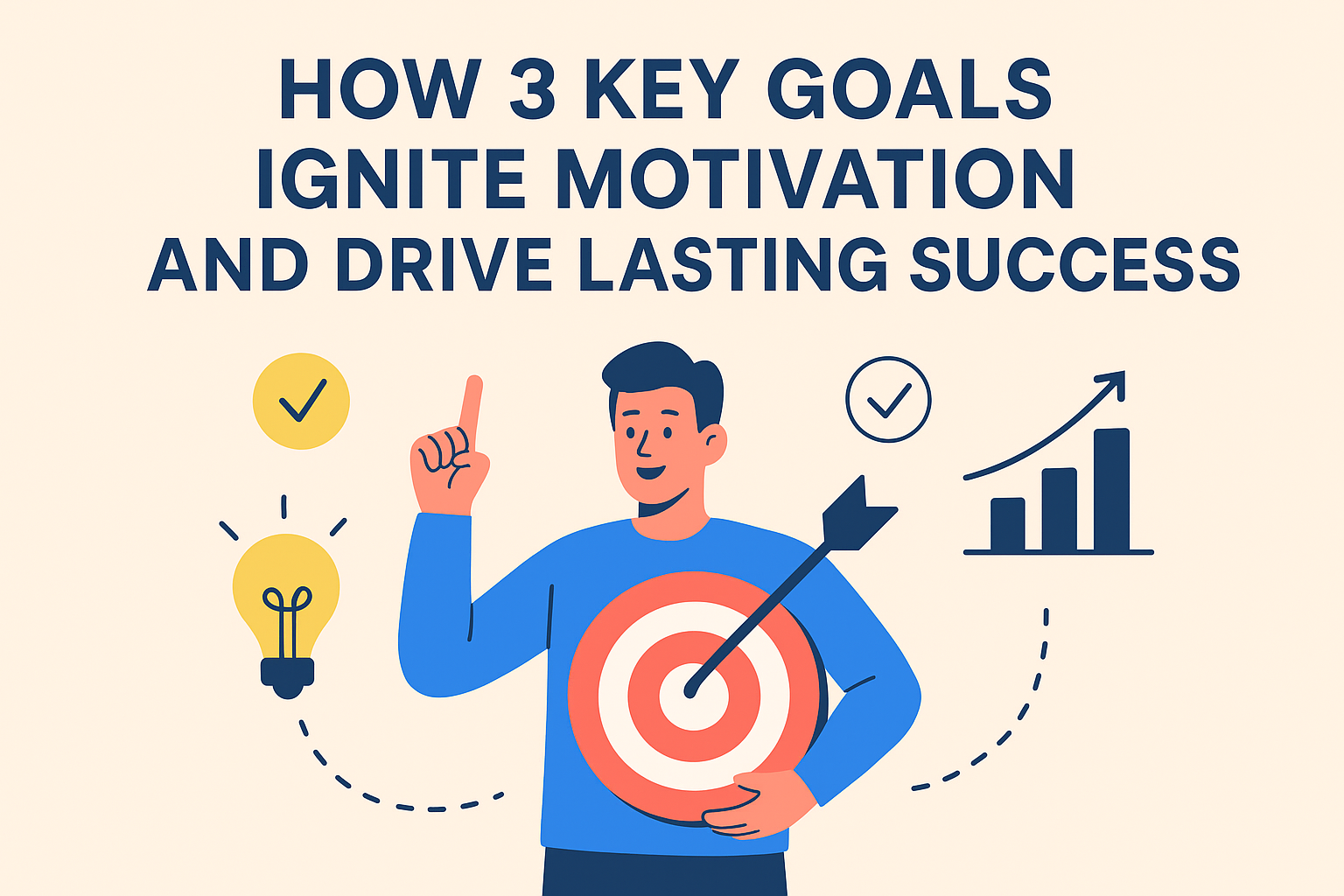You’ve tried long lists of New Year’s resolutions, sprawling to-do lists, and midnight “I’ll do it tomorrow” promises — and still found yourself stuck, unfocused, and low on energy. What if the secret to sustained motivation and real progress isn’t doing more, but choosing three goals so well that they become the magnetic north of your attention and action?
In this article you’ll learn exactly why three goals hit a sweet spot for motivation, how to pick the right three, and how to design practical, step-by-step systems that turn goals into regular action. This guide is for busy professionals, makers, students, and anyone who wants to stop spinning and start achieving—without burning out.
Key takeaways
- Less is more: Narrowing focus to three well-chosen goals reduces conflict and increases follow-through.
- Balance matters: Combine an outcome goal, a process/system goal, and a learning/competence goal to sustain motivation and adapt to changes.
- Make goals actionable: Use specific, measurable planning and “if-then” implementation steps to bridge intention and behavior.
- Build habits slowly: Habit formation varies by person; what becomes automatic for many takes around two months of consistent repetition.
- Track, review, and iterate: Frequent measurement and feedback keep motivation alive and allow smart course corrections.
Why three goals? The logic behind the magic number
What it is and core benefits
Choosing three priority goals means you intentionally limit your focus to a small, strategic set of objectives. The benefit is cognitive clarity: your attention, energy, and planning resources get concentrated on what matters most. Narrowing focus reduces internal conflict between competing goals, lowers overwhelm, and increases the odds of consistent progress.
Evidence and theory in brief
Psychological and organizational research shows that specific, challenging goals improve performance when paired with feedback and commitment. When people pursue many goals at once, attention and resources fragment — which can reduce performance, raise stress, and accelerate burnout. A modest number of complementary goals helps preserve mental bandwidth and prioritization.
Requirements / low-cost alternatives
- Requirements: time for reflection (30–60 minutes), a notebook or digital document for writing goals, a basic tracking tool (calendar or habit tracker).
- Low-cost alternatives: use a plain paper notebook, a simple spreadsheet, or a free habit-tracker app.
Step-by-step (beginner-friendly)
- Reserve 30–60 minutes in a calm setting.
- Write down everything you want to accomplish for the next 3–12 months.
- Circle the items that would create the most meaningful gains in your life or work.
- Reduce the circled list to three by asking: which three, if accomplished, would move the needle most?
- Write each of the three as a short, clear goal statement.
Beginner modifications and progressions
- Modify: If three feels like too few, start with one goal for 2–4 weeks and add the second and third later.
- Progression: Once you reliably sustain the first three for 3–6 months, rotate in new goals or introduce a “stretch” goal.
Recommended frequency / metrics
- Time spent deciding: one focused session (30–60 mins).
- Review cadence: weekly quick check-ins (10–20 mins) and monthly deep reviews (45–60 mins).
- Metrics: percent completion on milestones, streaks for daily habits, and one primary KPI per goal.
Safety, caveats, common mistakes
- Mistake: Choosing too many or vaguely worded goals. Avoid laundry-list phrasing.
- Caveat: Life events can force reprioritization — flexibility is not failure.
- Mistake: Selecting goals that conflict (e.g., “work 80-hour weeks” vs “be present for family dinner nightly”).
Mini-plan (2–3 steps)
- List 10 possibilities and highlight the top 5 impact items.
- Choose the top 3 using the “biggest outcome” test.
- Schedule the first weekly review in your calendar.
The three goal framework: What each goal does and why the trio works
A practical three-goal framework pairs one Outcome Goal, one Process/System Goal, and one Learning/Competence Goal. Together they create vision, sustainable action, and adaptive growth.
Outcome Goal (the destination)
What it is and core benefits
An outcome goal defines the end result you want (a promotion, a revenue target, fitness milestone). It provides direction and inspiration—the “why” you care.
Requirements / low-cost alternatives
- Requirements: a clear numeric or binary target and a deadline.
- Low-cost alternative: if numbers intimidate you, use descriptive success indicators (e.g., “able to hold a 5-minute plank” or “complete a client-ready portfolio”).
Step-by-step instructions
- Define the outcome in precise terms (what success looks like).
- Attach a realistic timeline.
- Break the outcome into major milestones (3–6).
- Assign one primary metric (e.g., revenue, weight lifted, number of clients).
Beginner modifications and progressions
- Modify: Turn a large outcome into a 90-day sprint with smaller milestones.
- Progression: Move from short-term outcome targets to annual or multi-year outcome ambitions.
Recommended frequency / metrics
- Check major milestones monthly.
- Track immediate leading indicators weekly (e.g., leads per week, workouts per week).
Safety, caveats, mistakes
- Mistake: Outcome without plan. Outcome goals without a system rarely stick.
- Caveat: Don’t anchor identity solely to outcomes—this reduces resilience when progress stalls.
Mini-plan (2–3 steps)
- Write the outcome as: “Achieve X by DATE.”
- List 3 milestones to get there.
- Pick one weekly metric to track.
Process / System Goal (the engine)
What it is and core benefits
A process or system goal defines the repeatable actions that reliably lead to the outcome. Instead of “get promoted,” a process goal is “complete two high-impact projects per quarter and document outcomes weekly.” Systems are motivational because they create momentum and reduce the need for perfect willpower.
Requirements / low-cost alternatives
- Requirements: an action plan, a daily/weekly habit structure, and a simple tracking tool.
- Low-cost alternative: use a paper checklist or calendar blocking.
Step-by-step instructions
- Identify daily/weekly actions that directly support the outcome.
- Set a minimum viable dose (the smallest meaningful action).
- Use implementation intentions: write exact cues and responses (e.g., “If it is 6:30 AM, then I will write for 20 minutes”).
- Track completion and adjust for friction points.
Beginner modifications and progressions
- Modify: Start with a 10-minute habit instead of 60 minutes.
- Progression: Increase frequency or intensity once consistency reaches 80% over 2–4 weeks.
Recommended frequency / metrics
- Daily micro-actions tracked daily.
- Weekly summary of total actions (e.g., sessions completed).
- KPI example: completion rate (%) and average time per session.
Safety, caveats, mistakes
- Mistake: Setting overly ambitious process goals (e.g., daily 2-hour deep work blocks when you haven’t built stamina).
- Caveat: Systems need periodic review to stay aligned with outcomes.
Mini-plan (2–3 steps)
- Choose one daily action tied to your outcome.
- Decide a time and cue for it.
- Track completion each day.
Learning / Competence Goal (the growth accelerator)
What it is and core benefits
A learning or competence goal targets skill development and mastery—how you get better over time. It fuels long-term motivation by giving you progress feedback even when outcomes are distant.
Requirements / low-cost alternatives
- Requirements: access to learning resources, time allocated for practice, and a way to measure skill acquisition.
- Low-cost alternatives: free online courses, books, mentors via coffee chats.
Step-by-step instructions
- Define the skill you need for the outcome.
- Break it into micro-skills or competencies.
- Create a practice plan with frequency and deliberate practice elements.
- Gather feedback (self, peer, coach).
Beginner modifications and progressions
- Modify: Begin with 15–20 minutes of focused practice daily.
- Progression: Increase practice time, add complexity, and seek external feedback.
Recommended frequency / metrics
- Practice frequency: 3–6 times per week depending on skill intensity.
- Metrics: measurable improvements (time to complete, accuracy, outputs produced).
Safety, caveats, mistakes
- Mistake: Passive consumption without deliberate practice or feedback.
- Caveat: Skill acquisition often has plateaus—expect and plan for them.
Mini-plan (2–3 steps)
- Choose one skill and a 20-minute daily practice.
- Set a performance metric (e.g., complete 5 targeted practice sets).
- Collect feedback weekly.
How to choose your three goals (practical decision method)
What it is and core benefits
A lightweight decision method helps you pick goals that are high-impact, feasible, and motivating. The benefits are better alignment with values and practical manageability.
Requirements / low-cost alternatives
- Requirements: clarity about values, a list of candidate goals, a scoring method.
- Low-cost alternative: use a three-column table on paper: Impact | Feasibility | Motivation.
Step-by-step instructions (30–45 minutes)
- Brainstorm 10–15 candidate goals.
- Rate each on three scales (1–5): potential impact, feasibility, and intrinsic motivation.
- Multiply or sum the scores and rank.
- Eliminate goals that score low on two or more scales.
- Pick the top three and test them with the “if achieved, would this change my life” question.
Beginner modifications and progressions
- Modify: If deciding is hard, pick the three that feel least stressful and revisit in two weeks.
- Progression: After 90 days, evaluate and replace goals that are low-impact or demotivating.
Recommended frequency / metrics
- Re-evaluate goal fit at 30 and 90 days.
- Metrics: subjective motivation rating (1–10) and objective progress (% of milestones reached).
Safety, caveats, mistakes
- Mistake: Choosing goals purely based on external expectations.
- Caveat: Short-term feasibility changes—adjust goals when life circumstances change.
Mini-plan (2–3 steps)
- Score candidate goals on impact/feasibility/motivation.
- Select top three and draft one-line statements for each.
- Schedule weekly check-ins.
Turn goals into action: tools and techniques that actually work
This section covers proven, practical techniques you’ll use daily to protect motivation and convert intentions into action.
What it is and core benefits
You’ll learn simple frameworks (SMART-style specificity, implementation intentions, habit-building practices, feedback loops) that translate vague goals into consistent behavior and measurable progress. These techniques increase the likelihood of goal attainment by strengthening the connection between cues, actions, and outcomes.
Requirements / low-cost alternatives
- Requirements: notebook or app for tracking, a calendar, and 15–30 minutes weekly for planning/review.
- Low-cost alternatives: paper planner, calendar apps, or free habit trackers.
Step-by-step instructions
- Make each goal SMART (Specific, Measurable, Achievable, Relevant, Time-bound).
- For each goal, write explicit implementation intentions: “If [cue], then I will [action].” This reduces decision friction.
- Build a tiny minimum-viable habit (the smallest version of the action you can commit to) and attach it to a stable cue.
- Track daily completions and weekly outcomes.
- Review weekly: celebrate wins, troubleshoot barriers, and adjust.
Beginner modifications and progressions
- Modify: reduce the minimum-viable habit to 5–10 minutes if needed.
- Progression: add complexity or volume once consistency is above 80% over four weeks.
Recommended frequency / metrics
- Daily habit tracking.
- Weekly review summaries (what worked, what didn’t).
- Monthly milestone checks.
Safety, caveats, mistakes
- Mistake: Relying only on willpower and motivation. Systems protect against willpower shortfalls.
- Caveat: Implementation intentions and habit formation help with initiation but won’t replace strategy or skill gaps.
Mini-plan (2–3 steps)
- Convert each goal to a SMART statement.
- Write one implementation intention for each.
- Start a daily check-in to record completion.
Habit formation — practical guidance (how long, how to speed it up, what to expect)
What it is and core benefits
Habits make important actions automatic by linking a cue to a response repeatedly. The benefit is that automatic behaviors consume less conscious energy, making sustained effort feasible.
Evidence highlights
Research tracking daily repetition of new behaviors shows habit automaticity strengthens over weeks and months; on average, many people reach the asymptote of automaticity in about two months, though the range is wide and dependent on the behavior and individual.
Requirements / low-cost alternatives
- Requirements: consistent cues, repetition, and minimal friction for the chosen action.
- Low-cost alternative: choose naturally recurring cues (after breakfast, on the commute home).
Step-by-step instructions
- Choose a cue anchored to an existing routine.
- Specify the exact action and a tiny duration (the minimum viable dose).
- Perform the action immediately when the cue occurs.
- Track completion daily for at least 6–12 weeks.
- After four weeks of steady repetition, consider increasing the dose.
Beginner modifications and progressions
- Modify: If daily is too much, start with every-other-day or 3x/week tied to a cue.
- Progression: Add complexity or duration gradually once the habit stabilizes.
Recommended frequency / metrics
- Frequency: whatever is logically tied to the cue (daily is ideal but not required).
- Metrics: streak length, percent of days completed in a 30-day window, and subjective automaticity score.
Safety, caveats, mistakes
- Mistake: Changing cues mid-experiment. Keep the cue stable.
- Caveat: Some habits (complex skills) take longer to feel automatic; don’t expect linear progress.
Mini-plan (2–3 steps)
- Pick a cue and the smallest useful action.
- Repeat daily and log each occurrence.
- Reassess at 30 and 66 days.
Tracking, feedback, and reviews: keep motivation alive
What it is and core benefits
Regular measurement and feedback close the loop between action and outcome. They preserve motivation by showing progress or signaling when course correction is needed.
Requirements / low-cost alternatives
- Requirements: simple tracking tool (habit tracker, spreadsheet, or journal) and a weekly review slot.
- Low-cost alternatives: use a physical calendar and check marks.
Step-by-step instructions
- Select one leading indicator per goal (e.g., sessions completed, words written, calls made).
- Record daily or weekly.
- Use a simple chart or progress bar to visualize momentum.
- Hold a 10–20 minute weekly review: wins, barriers, adjustments.
- Do a 45–60 minute monthly review for milestone checks.
Beginner modifications and progressions
- Modify: Track only weekly if daily tracking feels onerous.
- Progression: Add richer metrics (time-on-task, conversion rates) when needed.
Recommended frequency / metrics
- Daily for habit completion, weekly for leading indicators, monthly for outcomes.
Safety, caveats, mistakes
- Mistake: Obsessing over vanity metrics that don’t drive outcomes.
- Caveat: Choose KPIs that are actionable—metrics you can influence directly.
Mini-plan (2–3 steps)
- Pick 1–2 metrics for each goal.
- Log them in a single dashboard (spreadsheet or app).
- Schedule weekly reviews and monthly deep-dives.
Troubleshooting common pitfalls and how to fix them
What it is and core benefits
Problems will arise — this section gives quick fixes so you don’t stall when motivation dips or systems fail.
Typical issues and fixes
- Problem: You miss days and feel demotivated.
Fix: Reframe missed days as data; shorten the minimum dose and restart immediately. - Problem: Goals conflict or you feel stretched thin.
Fix: Temporarily deprioritize one goal or switch to sequential pursuit for a month. - Problem: You measure the wrong thing.
Fix: Switch to leading indicators that you can control rather than distant lag measures. - Problem: Plateau in progress.
Fix: Introduce deliberate practice, seek feedback, or change the practice context.
Requirements / low-cost alternatives
- Keep a small “solution kit” list of fixes and a trusted accountability buddy (free).
Step-by-step instructions
- When you hit a roadblock, stop and diagnose for 15 minutes.
- Identify whether the issue is motivation, skill, or logistics.
- Apply the targeted fix and re-run the next week.
Mini-plan (2–3 steps)
- Keep a “roadblock list” in your weekly review.
- Pick one roadblock and apply one fix this week.
- Measure the result next week.
4-week starter plan: practical roadmap you can use today
This compact, actionable plan assumes you’ve chosen your three goals (Outcome, Process, Learning). It’s designed to create momentum and a habit foundation quickly.
Week 1 — Clarify and commit
- Choose your three goals in one sentence each.
- Convert each to a SMART form and write one implementation intention per goal.
- Pick one minimum-viable action per goal (5–20 minutes).
- Schedule daily cues and add a weekly 20-minute review to your calendar.
Week 2 — Launch and iterate
- Start the minimum-viable actions each day.
- Track daily completion.
- At the end of the week, note blockers and adjust cues or the minimum dose.
- Celebrate a small win.
Week 3 — Build consistency
- Aim for increasing streaks.
- Add deliberate practice to your learning goal (structured feedback or a challenge).
- If you miss days, reduce the dose rather than pause entirely.
Week 4 — Stabilize and measure
- Do a robust weekly review: metrics, barriers, next month’s milestones.
- Adjust goals if they’re unrealistic or low-impact.
- Create a 90-day milestone plan.
Mini-sample tasks (for each week)
- Outcome goal: list milestones (Week 1), complete milestone 1 steps (Week 2), review progress (Week 4).
- Process goal: perform daily minimum action; track streak (Weeks 1–4).
- Learning goal: complete 3 deliberate practice sessions in Week 3; collect feedback in Week 4.
Quick-start checklist (warm-up before you begin)
- Block 45–60 minutes to choose your three goals.
- Convert each to a one-line SMART goal.
- Define one minimum-viable action and its cue per goal.
- Set up daily tracking (paper or app).
- Schedule weekly reviews and a monthly milestone check.
- Tell one accountability partner what you’re working on.
Measuring progress: KPIs and practical trackers
Suggested KPIs (one per goal)
- Outcome: percent of milestone completion or a numeric delta toward target.
- Process: sessions completed per week, streak length, or time-on-task.
- Learning: measurable skill metric (speed, accuracy, output quality) or time spent in deliberate practice.
Tools and low-cost options
- Spreadsheet dashboard (customizable).
- Calendar blocking (visual momentum).
- Habit-tracker apps (many free options).
- Physical journal for qualitative notes.
How to interpret data
- Use leading indicators for course correction (they tell you what to do this week).
- Use lag indicators to evaluate strategy (they show if your approach worked over months).
- Don’t chase daily fluctuations—watch trends across weeks.
Beginner modifications & progressions — keep scaling without burning out
Simplify when life gets busy
- Reduce frequency, not fidelity. Switch from daily to 3–4 times/week if needed.
- Shorten the minimum-viable action but keep the habit cue intact.
Scale smartly
- Double the time-on-task only after achieving at least 80% consistency for four weeks.
- Add complexity by layering new micro-tasks into the existing cue (habit stacking).
When to replace a goal
- Replace if it consistently scores low on your motivation metric or stops being impactful.
- Prefer rotation (pause one goal, introduce another) over abrupt abandonment.
Safety, ethics, and wellbeing caveats
- Don’t use goals to justify harmful behaviors (extreme dieting, unsafe shortcuts).
- Avoid tying self-worth only to outcomes; keep goals as experiments and learning journeys.
- If a goal has medical, legal, or financial implications, consult a qualified professional for personalized advice.
10 Practical mini-plans (2–3 steps each) — instant copy-paste starters
- Career outcome (promotion in 12 months)
- Identify 3 high-impact projects.
- Complete project 1 milestone within 30 days.
- Process (daily writing habit)
- Cue: first thing in the morning. Action: 15 minutes. Track daily.
- Learning (public speaking)
- Do one 10-minute recorded talk twice a week. Seek peer feedback weekly.
- Fitness outcome (run 10K)
- Process: run 3x/week. Week 1: 20-minute runs.
- Finance outcome (save X by year-end)
- Process: automatic transfer each payday. Track net balance weekly.
- Health learning (sleep hygiene)
- Practice a wind-down routine nightly for 21 nights; record sleep quality.
- Side project (launch newsletter)
- Week 1: draft 3 issues; week 4: publish first issue.
- Relationship goal (weekly date night)
- Block Friday evenings and alternate planning duties.
- Skill goal (learn a tool)
- 20 minutes daily tutorials + one project per month.
- Mindset goal (gratitude)
- Write three things you’re grateful for each night; review monthly.
FAQs (8–12 concise answers)
- Why three goals — why not one or five?
Three balances focus and flexibility: one can be the main priority, one supports the process, and one builds skills. Fewer than three limits growth options; more than three divides attention. - What if I fail at a goal?
Treat failure as data. Analyze causes, lower the dose, get support, and iterate. - How often should I review goals?
Quick weekly check-ins and a monthly deep dive work well; quarterly for big-picture adjustments. - Are outcome goals or process goals more important?
Both matter. Outcome gives direction; process sustains action. Process tends to be a better lever when motivation dips. - How long does habit formation take?
It varies widely, but many people report substantial automaticity after roughly two months. Expect individual differences. - How should I track progress without obsessing?
Use simple KPIs and a weekly review—avoid checking metrics multiple times daily unless necessary. - What if my goals conflict with each other?
Reassess and reprioritize. Temporarily pursue sequential strategies or adjust timelines. - What’s a good way to stay accountable?
Use a small accountability group, a coach, or a single trusted peer and report weekly. - Can I change my three goals?
Yes—adjust when priorities or life situations change. Review after 30–90 days. - How much time should I dedicate daily?
Start with a minimal viable dose: 10–30 minutes per goal depending on complexity. Scale up once consistent. - Do I need an app to succeed?
No. Apps help but a simple paper checklist and calendar work just as well when used consistently. - What if I feel demotivated after initial success?
Reconnect with the deeper purpose of each goal, redesign your rewards, and celebrate small wins to reignite momentum.
Conclusion — putting it all together
Setting just three key goals forces clarity, reduces conflict, and channels energy toward meaningful progress. When you combine a clear outcome, a reliable process, and a learning focus—while applying simple tools like implementation intentions, habit anchors, and weekly reviews—you build a self-sustaining system that powers motivation. Start small, measure honestly, iterate fast, and keep the long view: steady progress compounds into big results.
Call to action (one line, copy-ready): Pick your three goals now, write one implementation intention for each, and start your first daily action today.
References
- Building a Practically Useful Theory of Goal Setting and Task Motivation: A 35-Year Odyssey — PDF article, university-hosted copy, 2002. . Stanford Medicine
- There’s a S.M.A.R.T. Way to Write Management’s Goals and Objectives — PDF reprint of the original article explaining SMART goals, 1981. . Temple University Community
- Implementation Intentions: Strong Effects of Simple Plans — Review PDF summarizing meta-analytic evidence for implementation intentions and their effect on goal attainment (medium-to-large effects). . Cancer Control
- How are habits formed: Modelling habit formation in the real world — Research article (European Journal of Social Psychology) and related summaries describing habit automaticity and the typical 18–254 day range with median ~66 days. UCL news and open-access summaries also available. and research abstract . University College LondonWiley Online Library
- Self-Determination Theory and the facilitation of intrinsic motivation, social development, and well-being — Foundational overview and PDF on the psychological needs that fuel sustained motivation (autonomy, competence, relatedness). . Self Determination Theory
- An Integrative Review and Framework for the Study of Multiple Goals — Scholarly review covering the costs of goal conflict and strategies for managing multiple goals. . SAGE Journals
- How habits are formed: Modelling habit formation in the real world — open access summary — A practical review that summarizes the same habit-formation evidence and implications for behavior-change interventions. https://www.ncbi.nlm.nih.gov/pmc/articles/PMC3505409/. PMC





































Your point of view caught my eye and was very interesting. Thanks. I have a question for you.
Can you be more specific about the content of your article? After reading it, I still have some doubts. Hope you can help me.